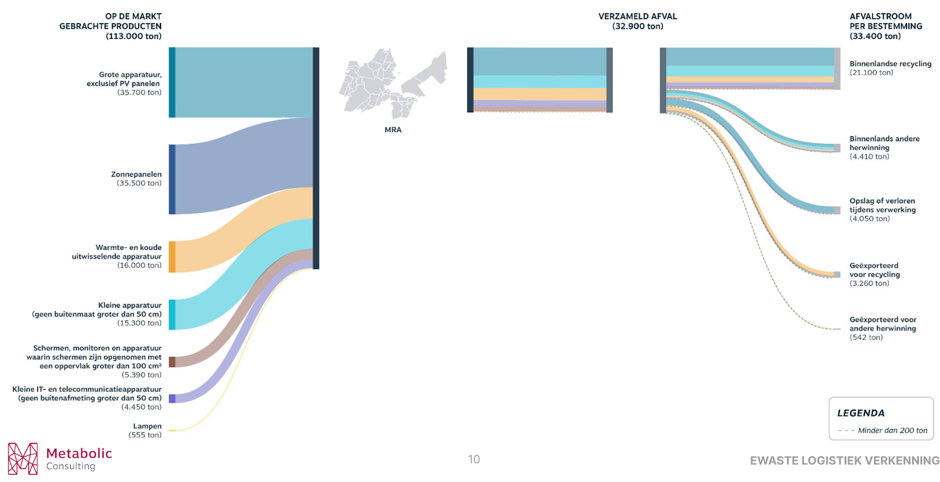The Netherlands, with a less than 50% collection rate, does not meet European standards for e-waste; there is too little waste of electrical and electronic equipment (WEEE) returned by consumers and businesses. Besides better collection and processing of e-waste, reducing use by limiting consumption, extending product lifespan, reuse, and repair is essential for a circular economy in electrical appliances.
The Dutch Topsector Logistics and CoE City Net Zero of the Amsterdam University of Applied Sciences have asked Metabolic to analyze the current e-waste flows and processing methods, regulations, and stakeholders in the Amsterdam Metropolitan Area.

Economic Value of the Dutch Logistics Collection Market
The economic value of the collection market is 900 to 1,000 million euros annually, 100 million euros for larger appliances, and 800 to 900 million euros for smaller household appliances and IT equipment, mainly in fine-mesh collection and sorting. This market is growing further in the coming years due to the increasing flow of returning solar panels. It concerns 1.6 million large appliances and 130 million smaller household appliances and IT equipment per year returning from the consumer and business market. Additionally, there are opportunities for the growing flow of solar panels.
Logistics service providers have opportunities to contribute to improving and renewing collection networks, the efficient processing of e-waste, and local repair and return concepts in urban areas.
The waste transport market (represented by Transport and Logistics Netherlands) has 400 collection and transport companies. These companies are the intermediaries between parties with residual materials and those with raw material needs. These companies have opportunities to organize collection networks, efficient e-waste processing, and local repair and return concepts.
Improving E-Waste Collection
Metabolic examined the opportunities and obstacles in urban area collection and outlined the contours for three possible improvement scenarios. Barriers in the WEEE chain hinder reaching the collection target of 65%, but they do not contribute at the system level to extending product lifespans.
The research identified the following collection problems:
- The new equipment on the market is increasing faster than the amount of WEEE collected.
- There is a need for better consumer and business education and low-threshold WEEE collection systems.
- Waste management and collection systems are fragmented and cost-focused, with little cooperation between parties.
- The collected WEEE is not always of the right quality for further processing.
- Some collected WEEE is lost due to export for reuse, destruction, disposal via residual waste, incorrect waste documentation, and processing by non-certified parties. There is insufficient insight into where leakages occur. Collection and processing are vulnerable to illegal trade.
- Extended producer responsibility (EPR) leaves much to the market and producers, not encouraging alternatives. The current system focuses primarily on recycling, making reuse and repair less common.
Steps for Better Collection
- Develop a more mandatory scheme through regulation or industry agreements.
- Encourage specialized collection structures for specific product categories.
- Develop and scale up new collection methods by logistics service providers.
- Involve consumers in the collection process by linking purchase and return, offering financial incentives, raising awareness, collection through producers, and improving return convenience through alternative channels.
- Develop instruments for consumer behavior change.
Circular Processing
After collecting WEEE, circular processing needs improvement, and there are systemic concepts and interventions to promote circularity:
- Reconsider the design of urban waste management, perhaps with more public involvement, to promote a more efficient and sustainable approach.
- A new policy framework to address the lack of coordination and stimulate a systematic circular approach. National and local governments are crucial in creating suitable conditions and setting examples.
- Implement clear laws and regulations. Chain objectives should be formulated with precise tasks for all parties involved.
- Shift from competition to collaboration between parties in collection and processing.
- Promote innovative circular business models, such as ‘Product-as-a-Service’.
- Organize sufficient processing space near cities. PBL states that by 2050, up to 40% more space is needed for the circular economy in general.
Metabolic’s Three Scenarios for Improving E-Waste Handling
Scenario 1: Market organization within strict frameworks, focusing on (cost) efficiency.
Scenario 2: Public-private organization with room for market dynamics, where the public sector addresses market limitations.
Scenario 3: Public organization emphasizing participation and broad welfare.
Collaboration in the Ecosystem
Collaboration between public and private parties in collection and processing is necessary. This collaboration can focus on the technical aspects of logistics: collection systems and techniques, clean vehicles, containerization, and the network of local repair and return points. It also involves sharing data on expected e-waste flows and proper processing.
Logistics companies can focus on three different types of synergy:
- Operational synergy: Efficiently performing a specific activity within the existing structure.
- Coordination synergy: Achieving alignment or coupling between parties within the existing structure, resulting in cost savings and service improvements through better coordination and cross-company optimization. An example is the joint waste collection by multiple logistics parties in cities with Green Collective.
- Network synergy: Structural benefits through changes in the network or modifications in logistics networks. Network synergy results in high-quality benefits but is more complex. Better collection and processing of e-waste require innovation in network synergy.
Follow-Up with Topsector Logistics
Metabolic and the Amsterdam University of Applied Sciences will conduct further research with involved companies, organizations, and public parties in the coming months. The intended result is a detailed elaboration of various logistics scenarios. Based on this, the following steps can be taken, such as testing a scenario with a pilot or living lab in practice or further developing logistics movements, spatial impact, and the business case of the scenarios through an outlook report.
This research was made possible by the CoE City Net Zero of the Amsterdam University of Applied Sciences and the Topsector Logistics.
Source: Report by Metabolic, Topsector Logistics, and Amsterdam University of Applied Sciences
